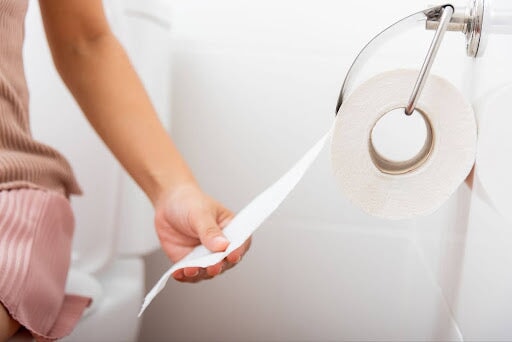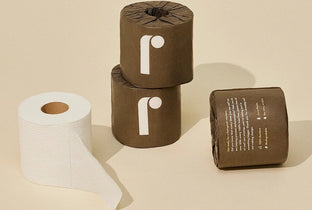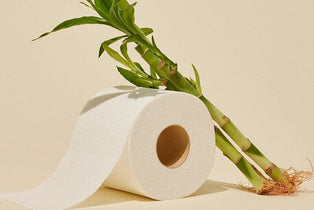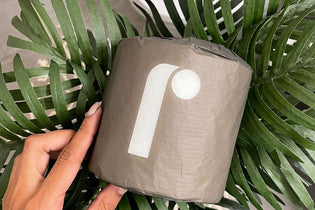
TLDR
In our everyday lives, toilet paper is a necessity, yet we rarely pause to think about how much we're using and its broader impact. As you embark on setting some sustainable New Year's resolutions or simply want to make a more eco-conscious lifestyle change, you can rely on this guide to learn more about the optimal amount of toilet paper to use, its environmental implications, and how choosing sustainable options like Reel Paper can make a significant difference.
Understanding Your Toilet Paper Needs
Toilet paper is an essential item in every household, yet its usage is often overlooked in our daily routines. Understanding your toilet paper needs is not only about ensuring comfort and hygiene but also about being mindful of consumption for environmental reasons. This is key to making informed decisions that balance practicality with sustainability.
Daily Toilet Paper Usage: What's Normal?
On average, toilet paper usage varies greatly from person to person, but did you know that the average American uses about 57 sheets of toilet paper per day? This amounts to 141 rolls per person per year [1]. That's a significant amount, especially when you consider it on a larger, household scale. It's essential to understand what constitutes 'normal' use to gauge if we're using more than necessary and where we can cut back. Recognizing the average usage can help in making more conscious decisions about consumption and looking for ways to optimize use without compromising on personal hygiene.
Factors Affecting Toilet Paper Consumption
Several factors can affect how much toilet paper a household uses. The number of people in a home is an obvious factor, but the quality of the toilet paper plays a crucial role too. For instance, higher quality, more absorbent paper like Reel Paper’s bamboo toilet paper might be used less in quantity compared to thinner, less absorbent varieties. Personal hygiene habits, health issues, and even the design of the toilet paper, like quilted or extra-soft varieties, are also key factors impacting overall consumption.
The Environmental Impact of Toilet Paper
The production and consumption of toilet paper have significant, often underappreciated, impacts on the environment. From the raw materials used to the manufacturing process, each aspect of toilet paper production contributes to its ecological footprint. Understanding these impacts is crucial for consumers considering sustainable swaps for the home or want to make environmentally responsible choices in their daily lives.
The Cost of Convenience: Trees and Plastic
The environmental cost of traditional toilet paper production is higher than one might expect. It involves not just the cutting down of trees but also significant water usage and the use of plastics in packaging. Each year, millions of trees are harvested for toilet paper, contributing to deforestation and a higher carbon footprint. The production process also involves bleaching and chemical treatments, adding to its environmental toll.
Reel Paper's Eco-Friendly Approach
Reel Paper offers an eco-friendly alternative with its bamboo toilet paper and recycled facial tissues. Bamboo, a fast-growing and sustainable resource, provides an excellent alternative to traditional wood pulp, significantly reducing the environmental impact. Furthermore, Reel Paper's commitment to plastic-free packaging and recycled content further lowers its products' ecological footprint, making them a smart choice for environmentally conscious consumers. By choosing Reel Paper, you are not only selecting a high-quality product but also contributing to lessening the demand for virgin wood pulp, a critical step in environmental conservation.
Choosing the Right Toilet Paper
Selecting the right toilet paper involves more than just considering softness and strength; it's also about understanding the environmental impact of your choice. Making an informed choice in this seemingly small decision can have a significant impact on both personal comfort and environmental conservation.
Quality vs. Quantity: What to Look For
When selecting toilet paper, it's important to find the right balance between quality and quantity. A softer, stronger roll may be more efficient per sheet, leading to less overall use. It's not just about the number of sheets per roll but also how effective each sheet is. Sustainability, such as that offered by bamboo toilet paper, should also be a key consideration. Factors like sheet size, ply (number of layers), and texture play a role in how much toilet paper is necessary for each use.
Reel Paper's Bamboo Toilet Paper
Reel Paper's bamboo toilet paper stands out as an exemplary choice. It offers a perfect blend of softness, strength, and sustainability. Bamboo toilet paper is often more durable and absorbent, meaning you might use fewer sheets compared to regular toilet paper. This efficiency, combined with its eco-friendly production, conveniently demystifies why bamboo toilet paper is so expensive and proves it is a worthy consideration for any household. The comfort and environmental benefits provided by Reel Paper's bamboo toilet paper make it an ideal choice for those looking to make sustainable swaps in their daily lives.
Practical Tips for Reducing Toilet Paper Waste
Reducing toilet paper waste is an important step toward a more sustainable lifestyle, and it's easier than you might think. From smart usage techniques to integrating complementary products, these strategies are designed to make your bathroom habits more eco-friendly while maintaining the comfort and cleanliness you expect.
Smart Usage: How to Use Less
Reducing toilet paper usage without compromising on hygiene is possible with a few practical tips. Consider using a toilet paper calculator to estimate the right amount for your household. Being mindful of each pull from the roll and educating family members about conservative use can make a significant difference. Encouraging the use of both sides of the paper and practicing folding instead of crumpling can also help reduce the amount used.
Complementary Products
Complementing your toilet paper use with products like bidets can drastically reduce the need for toilet paper. When comparing toilet paper vs bidet, bidets offer a hygienic and environmentally friendly way to clean up, often reducing toilet paper use by up to 75%. Other products like wet wipes (biodegradable ones) can also be used, but it’s crucial to ensure they are septic-safe. In bathrooms, installing hand dryers or using reusable towels instead of paper towels for hand drying can further reduce paper waste.
Making the Switch to Sustainable Toilet Paper with Reel
Transitioning to sustainable toilet paper options like those offered by Reel Paper is a straightforward yet impactful change every household can make. Not only do these products help in reducing the environmental impact associated with traditional toilet paper, but they also offer a high-quality experience. As we become more aware of our consumption habits and their effects on the environment, making mindful choices like opting for Reel Paper's bamboo toilet paper, recycled paper towels, and other eco-friendly products can contribute significantly to a more sustainable future.
Remember, every small step towards sustainability, like choosing the right toilet paper, can lead to a big positive impact on our planet. By embracing household paper products like those from Reel Paper, you're not just making a simple switch in your shopping habits; you're joining a growing community of consumers who prioritize both personal well-being and the health of our environment.
Sources:
- Pforzheimer, Adrian. 2020. “The Real Problem with Toilet Paper: Where It Comes From.” Frontier Group. April 24, 2020. https://frontiergroup.org/articles/real-problem-toilet-paper-where-it-comes/.
- The World Counts. n.d. “Environmental Impact of Toilet Paper.” The World Counts. https://www.theworldcounts.com/challenges/consumption/other-products/environmental-impact-of-toilet-paper.
- Atillo, Ernie. 2023. “Toilet Paper vs Bidet: Which Is Better?” Reel. December 7, 2023. https://reelpaper.com/blogs/reel-talk/toilet-paper-vs-bidet.




0 comments